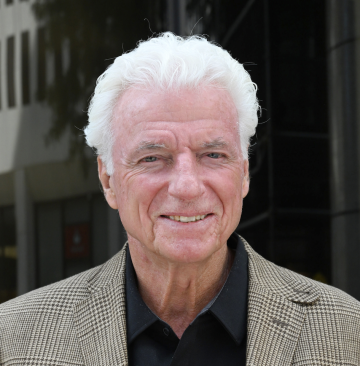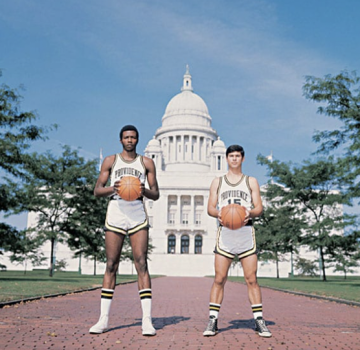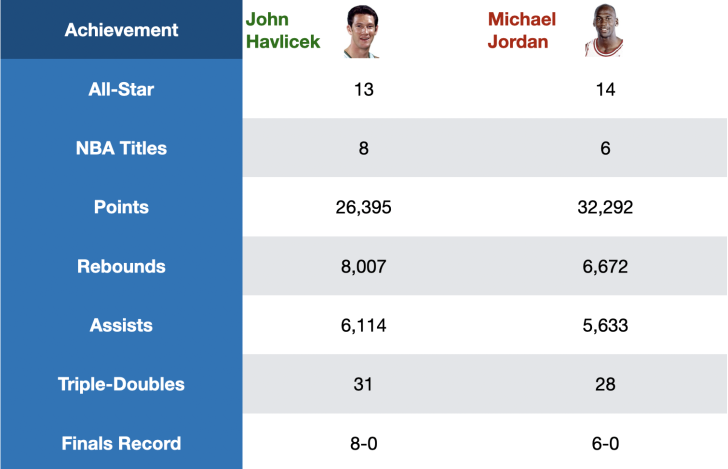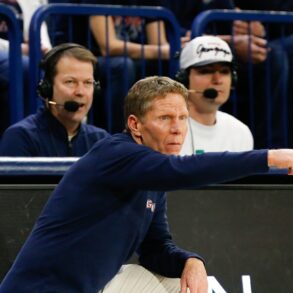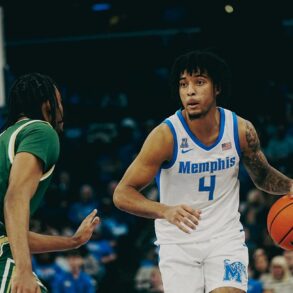Sunday, June 01, 2025
As all college basketball programs across the country, including our local favorites, begin to settle down to assess their newly acquired NIL pieces, and plan how to incorporate them with existing players remaining in the program along with whatever new recruits obtained from the newly graduated High School ranks, the NBA playoffs have taken center stage for basketball fans.
The NBA playoffs are when the intensity and drama get ratcheted up as the stakes become higher with each ensuing game, and those players with that innate ability to shine in those moments come to the forefront.
After witnessing Tyrese Haliburton’s incredible game tying step back jumper from the top of the key( which at first appeared it might have been a game winning 3), culminating a 17 point comeback and sending game one of the Pacer’s, Knicks Eastern Conference Finals at MSG into overtime, it jarred an association and memory from long ago.
GET THE LATEST BREAKING NEWS HERE — SIGN UP FOR GOLOCAL FREE DAILY EBLAST
It was game 7 of the NBA Finals in 1969, Lakers vs Celtics which turned out to be Bill Russell’s 11th and final Championship. The LA Forum had the balloons already in place and set to descend when Don Nelson’s 17’ jumper hit the back of the rim and just like Haliburton’s went way up above the backboard before fortuitously falling through the hoop, giving Boston the cushion it needed to escape with a 108-106 win.
I texted Nellie’s son Donnie (who I worked for as a Dallas Mavericks scout when he was GM) after witnessing Haliburton’s shot, and he responded that he too was reminded of Nellie’s historic basket, seeing that shot go down in the manner that it did.
Watching such clutch performances in present time you can’t help but think what are the characteristics that comprise an individual player’s makeup that allow him to perform at such a high level in such key moments.
My Teammates
As a former player, I was fortunate enough to play with what has to be labeled “generational” talents on both the collegiate and professional level.
In the former category Ernie D and Marvin Barnes were unique personalities and talents who were extremely driven competitors and both in possession of the “clutch gene” in spades.
What would possess Ernie on national TV in an Eastern Regional Final game vs. Maryland, ranked #2 in the country, for the right to go to the Final Four? Would flawlessly scoring 30 points in 27 minutes give us the foundation to secure that win and go on to the Final Four?
What enabled him to instantly calculate on the biggest stage of the Final 4, the physical and mental coordinates involved in launching behind the back passes to Marvin and myself effectively in rhythm, one famously from nearly 3/4 court?
What part of Marvin Barnes’ software and character besides his immense physical talents enabled him to average just under 19 rebounds, just over 20 points a game during the two years I played with him, leading our team to a 55 and 8 record, including an undefeated 30 and 0 at home in the newly minted Civic Center during that span (1972-1974)
As a portent of his career at PC, what made Joey Hassett as a freshman look me off when I came to run the ball down from him and proceeded to calmly drill a long-range jumper at a crucial point in a double-overtime game vs Boston College?
Fast forward to more recent times, we all witnessed after the fateful injury to Bryce Hopkins on January 3rd of ‘24, how Devin Carter went on to define his college career as a dominant game changer, and super clutch performer, going from a respectable 16.2 points/game to 19.7 points/ 8.7 rebounds/ 3.6 assists/ 1.8 steals, affecting games on both sides of the ball and securing his place as an NBA Lottery pick by the Sacramento Kings (14th).
Pros – Havlicek and Jordan
On the professional level no one I encountered embodied the elusive “clutch gene” more than John Havlicek who was one of those rare people whose genuine nature and real personality was even better than his public image One of the best ways to summarize and illustrate the enormity of his career is just to give a side by side statistical comparison to whom many consider to be the best of all time, Michael Jordan (Havlicek- 16 years, Jordan-15 years)
Well-documented “clutch gene “ for both men.
In the 2022- 2023 season, the NBA instituted the NBA Clutch Player of the Year Award.
The NBA defines a clutch player as the “player who delivers most when the game is on the line.” Per the NBA, “clutch time” consists of the final 5 minutes of the 4th Quarter or overtime when the score is within 5 points.
Winner of the last 3 years
22-23: DeAaron Fox
23-24: Stephen Curry
24-25: Jalen Brunson
Of course, in today’s NB,A they have a statistical formula to help determine who the most clutch player is:
Brunson finished 2nd in total clutch points (156) by a single point; Anthony Edwards (157) But he reached his total in fewer clutch minutes( 135.3 to 160.4) and at a more efficient clip:
Brunson 1.15 points per clutch minute more than Jokic’s 1.0, Edwards’ .98
Don Nelson Sr., my old teammate and my boss in the NBA, would say, “You scouts always repeat the times that you were right but never repeat when you’re wrong.” Guilty as charged.
When I first saw Brunson play, it was at his senior year of High School, the McDonald’s All-American game in Chicago (2015), and I thought to myself that Jay Wright (Villanova) was going to get an excellent college point guard who would run his team for the next four years. My first impression was that he would be a solid college player with not that much of an upside in terms of playing at the next level.
But over the next 3 years he began to grow on me in terms of his value and his unique way of compensating for an obvious lack of eye catching athleticism, speed, quickness with a deception grounded in a firm grasp of fundamentals and footwork and featuring a better than 2 1/2 to 1 assist to turnover ratio It finally dawned on me after a game he had against Marquette his junior year that I was seriously underrating him and I quickly had him upgraded in my rankings to a mid 1st rounder somewhere in the teens.
Donnie Nelson was so pleased on the 2018 draft night in having just pulled off a trade to move up from the 5th pick to #3 in order to get Luka Doncic. Then, he allowed me to have a major say in selecting Jalen Brunson over a considerable amount of skepticism, including the head coach and the owner, with the 33rd pick in the second round. The team psychologist, having loved his interview, helped tip the scales in my favor at the last minute.
To be honest, I’m not saying that I foresaw this level of stardom for Brunson but obviously the team psychologist was able to identify some intangible in his character and personality when he blurted out from the corner of the draft room as he felt the tide moving against me,“we need someone with his kind of balls on this team!”
The good brain doctor obviously was able to detect the “clutch gene,” which enables a player to aggressively seek the opportunity to perform at optimum capacity in crucial situations.
Brunson has raised the level of his game to the point where even the casual fan doesn’t need a computer generated analytical analysis of what he brings at crunch time You can just sense in those situations that he’ll usually generate some positive outcome, whether a step back 3, a hesitation tricky drive to the hoop initiating contact along the way, making the right read on a pick and roll, running Dirk one hander off one leg, etc, always with great footwork involved.
It seems he’s met his match, however, in a team, Indiana, and a player, Haliburton, who’s also in possession of a highly developing “clutch gene,” making for an interesting battle.
In 2008, a book was published, “Outliers” by Malcolm Gladwell. It put forth the theory that all accomplished experts in any field of endeavor had one thing in common: they spent at least 10,000 hours of dedicated practice towards perfecting their skills in that field. It was based primarily on the research of K. Anders Ericsson, who examined accomplished musicians. It’s subsequently been picked apart since then as a gross oversimplification (including by the lead researcher Ericsson), due to its not taking into account the right kind of practice, inherited talent level, motivation, among other factors.
But what they don’t deny is the basic premise of the inordinate amount of time and effort that goes into any performer being able to draw upon in an instant the right response to execute in a space of calm and quiet in the midst of raucous mayhem and urgency.
The other element noted in the critique of this book is the importance of the age at which an individual begins his journey to acquiring said skill—not surprisingly, the earlier, the better. The two great clutch players we drafted that year in 2018, Doncic and Brunson, also had that in common—they were both initiated into the sport by parents, who themselves were pros, at a very young, single-digit age.
I can assure you that all the names mentioned above have more than satisfied the prerequisite of the 10,000 rule.
There’s a lot more to my old friend Don Nelson’s saying that “the cream always rises” than meets the eye.
Kevin Stacom is one of the most accomplished Providence College basketball players in history. An All-American at Providence, Stacom was a second-round NBA draft pick, played six years in the NBA, and won an NBA championship as a member of the Boston Celtics.
After his playing career, Stacom coached at the college level and served as an NBA scout for nearly 30 years for the Golden State Warriors and Dallas Mavericks.
Related Articles
Enjoy this post? Share it with others.
This post was originally published on this site be sure to check out more of their content.





